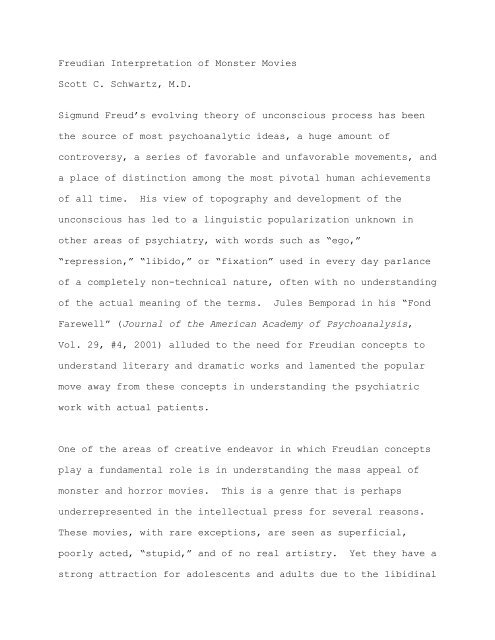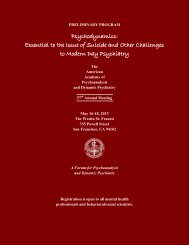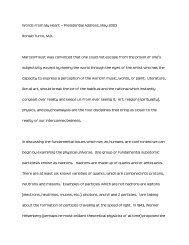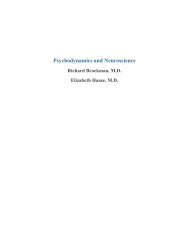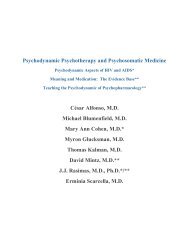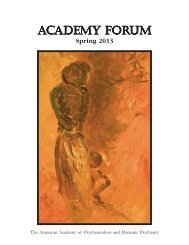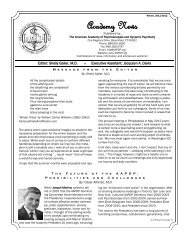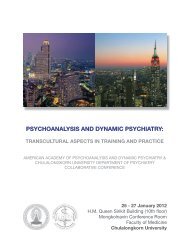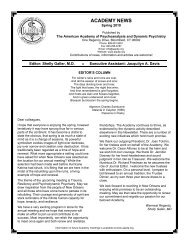Freudian Interpretation of Monster Movies Scott C. Schwartz, M.D ...
Freudian Interpretation of Monster Movies Scott C. Schwartz, M.D ...
Freudian Interpretation of Monster Movies Scott C. Schwartz, M.D ...
You also want an ePaper? Increase the reach of your titles
YUMPU automatically turns print PDFs into web optimized ePapers that Google loves.
<strong>Freudian</strong> <strong>Interpretation</strong> <strong>of</strong> <strong>Monster</strong> <strong>Movies</strong><br />
<strong>Scott</strong> C. <strong>Schwartz</strong>, M.D.<br />
Sigmund Freud’s evolving theory <strong>of</strong> unconscious process has been<br />
the source <strong>of</strong> most psychoanalytic ideas, a huge amount <strong>of</strong><br />
controversy, a series <strong>of</strong> favorable and unfavorable movements, and<br />
a place <strong>of</strong> distinction among the most pivotal human achievements<br />
<strong>of</strong> all time. His view <strong>of</strong> topography and development <strong>of</strong> the<br />
unconscious has led to a linguistic popularization unknown in<br />
other areas <strong>of</strong> psychiatry, with words such as “ego,”<br />
“repression,” “libido,” or “fixation” used in every day parlance<br />
<strong>of</strong> a completely non-technical nature, <strong>of</strong>ten with no understanding<br />
<strong>of</strong> the actual meaning <strong>of</strong> the terms. Jules Bemporad in his “Fond<br />
Farewell” (Journal <strong>of</strong> the American Academy <strong>of</strong> Psychoanalysis,<br />
Vol. 29, #4, 2001) alluded to the need for <strong>Freudian</strong> concepts to<br />
understand literary and dramatic works and lamented the popular<br />
move away from these concepts in understanding the psychiatric<br />
work with actual patients.<br />
One <strong>of</strong> the areas <strong>of</strong> creative endeavor in which <strong>Freudian</strong> concepts<br />
play a fundamental role is in understanding the mass appeal <strong>of</strong><br />
monster and horror movies. This is a genre that is perhaps<br />
underrepresented in the intellectual press for several reasons.<br />
These movies, with rare exceptions, are seen as superficial,<br />
poorly acted, “stupid,” and <strong>of</strong> no real artistry. Yet they have a<br />
strong attraction for adolescents and adults due to the libidinal
themes they act out and the conflicts they portray, as well as<br />
the transferential heroes, villains, and situations presented.<br />
Nonetheless people are loathe to admit to actually “liking” such<br />
movies and will <strong>of</strong>ten “brown bag” them home from the store,<br />
uncomfortable to admit ever actually to watch them. (“For my<br />
kids, you know.”) It is noteable that the great Oscar-winning<br />
films are made once, but many teen horror or monster movies have<br />
sequels, in the “Return <strong>of</strong> ...” “Part 2,” It Lives ...,” etc.<br />
Some, like “Friday The 13 th ,” “Halloween,” “Scream,” or “Elm<br />
Street” are up to five or six sequels. Despite the clear disdain<br />
that intellectuals generally feel for such films, their success<br />
is a signal <strong>of</strong> the repression necessary for people to maintain a<br />
façade <strong>of</strong> sophistication and maturity.<br />
In general terms, these productions can be classified into<br />
several broad categories over the past fifty years <strong>of</strong> their<br />
existence. The first, <strong>of</strong>ten made in Japan in the 1950’s, has<br />
some variation <strong>of</strong> the following: A group <strong>of</strong> miners or fishermen<br />
discover in a secluded cave a very large egg, unlike anything<br />
ever seen before. The authorities are notified, and the egg is<br />
brought to the central lab for study where, due to an error in<br />
incubation, it hatches and produces some sort <strong>of</strong> creature that<br />
promptly eats the lab and several cleaning people. Out on the<br />
street it begins a rampage eating everything in sight – people,<br />
cars and buildings – and nothing can stop it. The army is
called, and despite modern weaponry the creature eats tanks,<br />
trucks, soldiers, helicopters and jet fighters. For special<br />
effect it goes into the countryside and eats high-tension power<br />
lines. Rows <strong>of</strong> scientists pore over microscopes while generals<br />
study maps, all without success, to plot the course <strong>of</strong> and thwart<br />
the creature. There is <strong>of</strong>ten a pretty girl reporter, who is<br />
trapped somewhere and is menaced by the monster. All seems<br />
dismal, but suddenly a young boy gets into the strategy room,<br />
past the guards, and suggests a bottle <strong>of</strong> thorium (or a similar<br />
substance) might work. A bottle, the last one, is located, and a<br />
semi-suicidal volunteer drives up with a bazooka, firing the<br />
bottle into the gaping jaws <strong>of</strong> the monster who, upon swallowing<br />
it, falls over dead. In great triumph, the boy is paraded<br />
through the streets and marries the girl reporter.<br />
This vignette, representative <strong>of</strong> so many low-budget black-and-<br />
white movies, demonstrates a highly aggressive oral creature that<br />
uses its mouth to conquer the world, to place a sexual object in<br />
a helpless position, and ultimately to be killed. The powerful<br />
oedipal figures <strong>of</strong> the scientists and generals are completely<br />
ineffectual in controlling the sexual and aggressive force <strong>of</strong> the<br />
libido-based monster, but pure innocent virginality is the<br />
triumphant hero, and through the victory over the libidinal<br />
forces is able to achieve adult genitality and marital union.<br />
The oral quality <strong>of</strong> this scenario is augmented by the monsters
themselves, which <strong>of</strong>ten take on a cartoon-like appearance, and<br />
the protagonists who are <strong>of</strong>ten children.<br />
The second broad category, the natural disaster movie, became<br />
popular in the 1960’s with “Earthquake” “Crack in the Earth”<br />
“Krakatoa,” “Tsunami,” and “Avalanche” as examples, and persists<br />
up to the present with works like “Asteroid,” “The Perfect<br />
Storm,” “Deep Impact” and to a lesser degree “Titanic.” In these<br />
movies people fall into huge cracks that form, sometimes spewing<br />
out hot liquid, diarrhea-like lava that burns everything in its<br />
path. Buildings fall, crushing life with huge brown fecal-<br />
appearing fragments, or great brown boulders roll down<br />
destructive paths. Dams break, the avalanche overwhelms, and<br />
people are smothered or drowned in liquid and semi-liquid floods.<br />
The clear anal and urinary metaphor lacks a human or animal<br />
protagonist, but there is usually a thinly crafted story closely<br />
related to the earlier oral ones. The hero is somehow<br />
misunderstood by the oedipal, aggressive power structure.<br />
Despite his adamant timely warnings <strong>of</strong> the impending disaster,<br />
the authorities pay no heed, and only the beautiful and equally<br />
misunderstood heroine sees the truth. All the incompetent<br />
authorities are killed by the force <strong>of</strong> the disaster, but by using<br />
their strength and cunning, the hero and heroine narrowly escape<br />
nature’s fury and strengthen their love. These films, more than<br />
oral movies, introduce a rudimentary moral code as well: All
virgins survive, and all addicts or alcoholics are killed. All<br />
clergy sacrifice themselves for others, but anyone selfish dies a<br />
horrible death. Also, more than oral firms, the concept <strong>of</strong> the<br />
“Sleeping Giant” is seen, the idea that the destructive power can<br />
be overcome but never conquered and certainly never destroyed.<br />
This idea can be compared to the libidinal impulses, which can be<br />
tamed but not ever removed.<br />
With the advent <strong>of</strong> “slasher” movies, the emphasis switches to<br />
penetration as a tool <strong>of</strong> aggression and sexuality; almost any<br />
sharp object is wielded for this purpose. One can see chainsaws,<br />
scalpels, electric drills, long nails, coat hangers, and all<br />
manner <strong>of</strong> knives used to inflict damage. So many popular titles<br />
fall in this category that they have become parodies <strong>of</strong><br />
themselves. As in the other types, there is always an oedipal<br />
figure who meets a particularly gruesome fate. There is a strong<br />
sexual-aggressive movement, in that most victims are scantily<br />
clad, rather disdainful young men or women sometimes murdered in<br />
pleno delicto. Unattainable objects <strong>of</strong> desire are killed while<br />
kindly old lonely-hearted grandparents survive. The rudimentary<br />
morality <strong>of</strong> the disaster film is augmented to include likeable<br />
and unlikable people. This addition unwittingly confers on the<br />
hero and heroine a grandiose power over the lives <strong>of</strong> everyone<br />
around them: all good friends survive, and anyone who is mean or<br />
even disinterested is a victim.
Immediately noticeable is the fact that, like in disaster movies,<br />
the libidinal creature is quelled by the strength <strong>of</strong> the hero but<br />
never obliterated, and the wounded slasher, due to his<br />
diabolically inexplicable power, will return some day. Thus the<br />
triumphant relief is only temporary, just as our control over<br />
unconscious urges also is only temporary. It should also be<br />
remarked that the villain is quite indistinct in these movies<br />
versus in crime or cowboy movies, very much in accord with<br />
<strong>Freudian</strong> constructs. Is the monster truly the villain, or is the<br />
non-understanding, uncaring oedipal figure truly the villain? By<br />
murdering all the negative, morally unfit abusers, the monster in<br />
fact saves the hero’s virtue and safely accomplishes what the<br />
hero cannot do while remaining pure.<br />
Ironically, carefully etched character studies make the purpose<br />
<strong>of</strong> aggression more clearly defined. In films such as “High Noon”<br />
or “The Untouchables,” the hero has to confront the forces <strong>of</strong><br />
evil and take the risk <strong>of</strong> contaminating his non-violent image, as<br />
well as his own purity, by personally killing the villains. The<br />
bad guy’s motives are also easy to see – greed, power, or<br />
vengeance. Nobody cheers for him. In monster movies the<br />
slasher/monster becomes a way to get the hero into a position <strong>of</strong><br />
control and confident sexual functioning, previously impaired by<br />
those who become the victims <strong>of</strong> the violence. In later Japanese<br />
monster movies, Godzilla, originally a destructive tyrannosaurus-
like creature, is resurrected into a mighty protector <strong>of</strong> humanity<br />
against other monsters; like a huge watch dog he can be summoned<br />
by a boy who has the capacity to forge a special friendship with<br />
him. Thus the libidinal force is not defeated but redirected to<br />
fight other destructive impulses.<br />
The fact that so many movies contain elements identical to, or at<br />
least related to, specific psychoanalytic notions derived<br />
directly from Freud would be hard to consider a pure coincidence.<br />
Nor would it be reasonable to assume that every screenwriter,<br />
producer, director, and viewer <strong>of</strong> horror movies has studied<br />
psychoanalytic theory. Yet the popularity <strong>of</strong> such films is<br />
clearly based on their very direct appeal to the viewer.<br />
It is unfortunate that Freud’s theories have become politicized<br />
and rejected. In my own analytic framework, that <strong>of</strong> Karen<br />
Horney, Freud’s perspective is replaced by a theory that I find<br />
works for the treatment <strong>of</strong> emotional illness in my patients.<br />
That is, however, a matter <strong>of</strong> personal style. I find that the<br />
<strong>Freudian</strong> understanding <strong>of</strong> unconscious psychosexual growth through<br />
the redirecting <strong>of</strong> libidinal energy is a powerful and apparently<br />
valid way <strong>of</strong> reaching an audience and interpreting the ubiquitous<br />
cultural phenomenon <strong>of</strong> horror movies.<br />
Dr. <strong>Schwartz</strong> is a Fellow <strong>of</strong> the Academy; Assistant Pr<strong>of</strong>essor, New<br />
York Medical College; and Attending Psychiatrist, Metropolitan
Hospital, New York City<br />
Corrspondence to: 829 Park Avenue, New York, NY 10021<br />
Author OK 6/3/03


